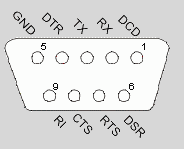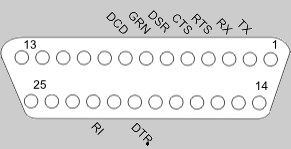RS-232
|
RS-232 is the name of an interface for the interchange of serial binary data between two devices. Serial means that the data bits are send one by one after the other. RS-232 was commonly used in computers to connect devices like a printer or a telephone modem. In computer terminology the RS-232 connector is often referred to as the "serial port". The RS-232 port is not much used anymore. Connection of devices is nowadays done through the use of USB.
RS-232 is defined by RETMA, a predecessor of the Electronic Industries Association (EIA). Hence the name RS, RETMA Standard. RS-232 was initially developed to standardize the connection of computers with telephone line modems. The standard allows as many as 20 signals to be defined, but gives complete freedom to the user. Three wires are sufficient: send data, receive data, and signal ground. The remaining lines can be hardwired on or off permanently.
Common connectors in personal computers use either a 9 pins or a 25 pins connector.

|
 |
| A 9-pins RS-232 connector. | A 25-pins RS-232 connector. |
The signals used for the connectors are:
| 1 | 8 | DCD | Data Carrier Detect | IN |
| 2 | 3 | RX | Received Data | IN |
| 3 | 2 | TX | Transmitted Data | OUT |
| 4 | 20 | DTR | Data Terminal Ready | OUT |
| 5 | 7 | GND | Ground | - |
| 6 | 6 | DSR | Data Set Ready | IN |
| 7 | 4 | RTS | Request To Send | OUT |
| 8 | 5 | CTS | Clear To Send | IN |
| 9 | 22 | RI | Ring Indicator | IN |
The signal transmission is bipolar, requiring two voltages, from 5 to 25 volts, of opposite polarity. Voltages above +3 V indicate an "ON" or 0-state condition. This state is also called SPACE. A voltage below -3 V indicate an "OFF" or 1-state condition. This state is also called MARK. The area between -3V and +3V is called the "dead area". This area is used to cope with noise on the line.
Modern computer equipment does not use the negative voltages and accepts a zero voltage as the "OFF" state. In this case the "ON" state is usually pwered by a signal level of +5V. However, this reduces the transmission distance dramatically.